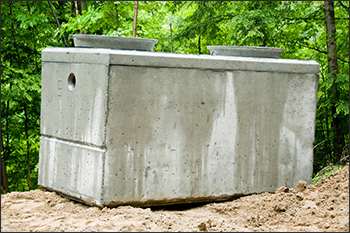How Sewer And Septic Systems Work
Premier Plastics Inc. has 25 years' experience with engineering design and installation of below ground septic tank alternatives. The key design factor of poly septic tanks for below earth use is the amount of resistance to compression buckling or pressure from the outside in. This is complete opposite to above surface tanks where in fact the pressure is from the within out. The key design factor is the tensile strength of the materials. To avoid buckling, below ground tanks have a thicker wall and are typically spherical in shape with light ribbing, or non-spherical (loaf condition) with heavy ribbing. The small toned triangular ribbing design of our SuperTanks keeps the stresses in-line with the smooth surfaces which bring about a account that resists pressure evenly from the very best, the sides, and the ends of the tank. No others tank design can lay claim this. Never grind up (macerate) your sewage before mailing to a septic tank unless essential. Pumping treated sewage (after septic container) up to the leach field with lift station is obviously an option, but do not macerate (pump) effluent prior to the septic reservoir. The septic reservoir operates by digesting solids and settling sludge to underneath and allowing grease to float to the top of the septic tank. Macerating the sewage before getting into the septic tank will create a septic tank without any large solids, only a cloud of surface up sewage contaminants. Once you send these particles out to the leach field, you are destined to eventually clog the land with bio-mat and then your leach field fails.
If you're going to sell or buy a property and are unsure whether the septic tank system is compliant, you can apply for a System Compliance Statement. Upon receipt of a credit card applicatoin and payment of the article cost, Council's Environmental Health Officials will research and establish if the system is compliant with current requirements.
Your septic system site plan is typically drawn right on top of your premises survey displaying the septic fish tank 'setbacks' with tank 5-10 legs from the house, the leach field at least 20 legs from the house, at least 100 toes from wells and channels, 25 feet from dry gulches, and 10 foot away from the property lines. Or whatever the local regulatory officials require, so always check with the county first for minimum amount setbacks.
Pump out and have the septic tank system inspected by a professional every 3 years. Failure to pump out the septic container is the most common cause of septic system failing. When the septic fish tank fills up with an excess of solids, the wastewater won't have enough time to stay in the reservoir. These unwanted solids will then pass on to the drain field where they will clog the drain lines and ground.
South Dakota is rolling out a recognition program for septic container system installers. This program ensures that the installers understand the look requirements. To become a certified installer you will need to go away a test with a rating of 70% or higher. You may either submit an internet request or a written request for a duplicate of the test or contact Scott Hipple at (605) 773-3351. Also, please contact Scott if you have any questions about septic tanks or installer official certification. The Department sustains a list of qualified installers for use by the general public.
Source: http://szamba-online.pl
If you're going to sell or buy a property and are unsure whether the septic tank system is compliant, you can apply for a System Compliance Statement. Upon receipt of a credit card applicatoin and payment of the article cost, Council's Environmental Health Officials will research and establish if the system is compliant with current requirements.
Your septic system site plan is typically drawn right on top of your premises survey displaying the septic fish tank 'setbacks' with tank 5-10 legs from the house, the leach field at least 20 legs from the house, at least 100 toes from wells and channels, 25 feet from dry gulches, and 10 foot away from the property lines. Or whatever the local regulatory officials require, so always check with the county first for minimum amount setbacks.
Pump out and have the septic tank system inspected by a professional every 3 years. Failure to pump out the septic container is the most common cause of septic system failing. When the septic fish tank fills up with an excess of solids, the wastewater won't have enough time to stay in the reservoir. These unwanted solids will then pass on to the drain field where they will clog the drain lines and ground.
South Dakota is rolling out a recognition program for septic container system installers. This program ensures that the installers understand the look requirements. To become a certified installer you will need to go away a test with a rating of 70% or higher. You may either submit an internet request or a written request for a duplicate of the test or contact Scott Hipple at (605) 773-3351. Also, please contact Scott if you have any questions about septic tanks or installer official certification. The Department sustains a list of qualified installers for use by the general public.

Source: http://szamba-online.pl